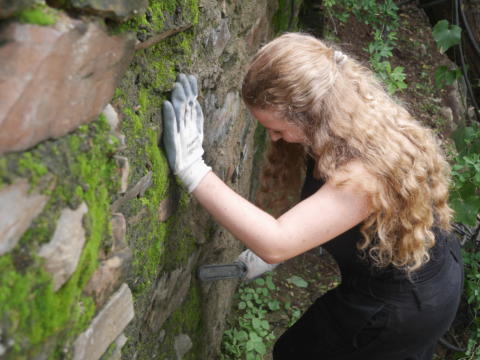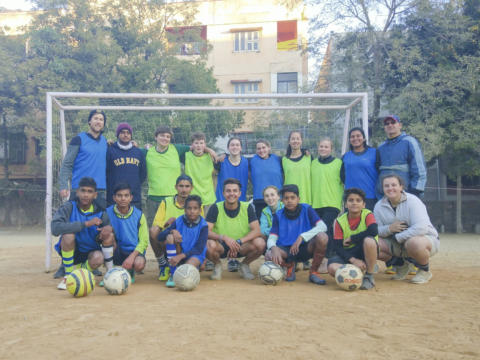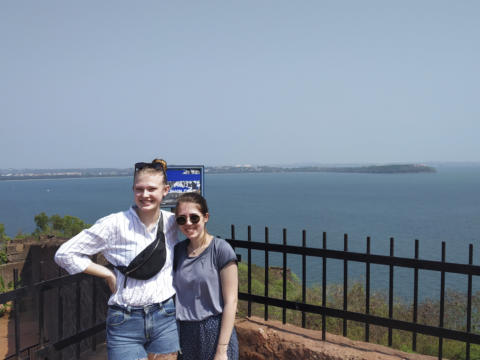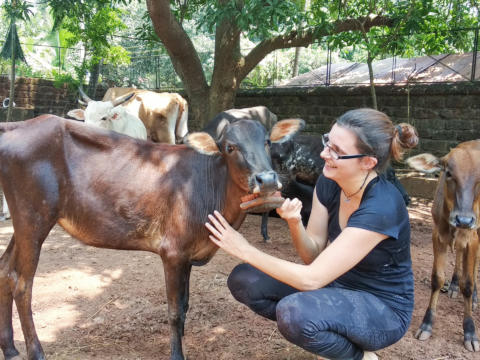Only 360€ per week!
Culture Week
Goa - India
Get familiarized with the customs, culture, surroundings and more of this rich and colourful country.
Experience the beauty and culture of Goa, get to know the people, explore its natural treasures, relax on its pristine beaches, visit local markets, historic forts and churches and learn about Goan history and heritage. Learn to cook an Indian meal and take home with you an unforgettable experience.
Program Description
This program lets you explore the life and style of Goan people. This is a very important step that will prepare you for your stay in India. Loads of new things will be introduced to you and it will be the time to ask all your questions about the organization, the programs, the country, the culture and anything else that might come to mind.
Moreover, there will be language lessons, cooking classes, yoga sessions, sightseeing, visits to authentic Indian homes, workshops that will introduce you to the culture, visits to our project locations and much more!
You will also have the opportunity to learn about the projects which you will be participating on and training will be given to your prior to beginning your project the following week.
Local language communication will be part of this program, hands-on Indian cooking class, yoga sessions, visiting scenic sights and surroundings, and project training workshops. All these encompass this week making your entry to the Goan life.
Aims & Objectives
The purpose of this program is to help you get an understanding of the manners, norms, and etiquette that is inherent in Indian society as well as show you around and introduce you to your new surroundings.
Schedule
Monday
7:00 – 8:00 Breakfast at the Center
8.30 – 9:30 Introduction to the program including code of conduct and Do’s and Don’ts (House Rules).
9:30 to 11:30 Visit to Old Goa and Spice Plantation
12.30 – 13:30 Lunch at Spice Plantation
14.00 – 17:00 Mapusa city visit and the local Market
18.00 – 19:00 Dinner at the Center
19:30 – 20:30 Relax for the evening
Tuesday
7:00 – 9:00 Self Defense classes
9:15 – 9:45 Main Course Breakfast
10:00 – 12:30 Join a practical session of Indian Cooking
12:30 – 13:30 Lunch at the Center
14:00 -17:00 Sightseeing tour to visit Candolim & Sinquerim Beach
18:00 – 19:00 Dinner at the Center
19:30 onwards Culture shock, discussion about safety and transport.
Wednesday
7:00 – 8:00 Breakfast
8:15 – 10:00 Yoga session
10:30 – 12:15 Local Language Lesson, (Alphabets, sentences, phrases, names of fruits and vegetables, numbers); a short break to learn making Indian Chai (tea)
12:30 – 13:30 Lunch at the Center
15:00 – 19:00 Anjuna Beach and market visit
19:00 – 20:00 Dinner at the Center
20:30 onwards Enjoy a Bollywood movie at the Center
Thursday
7:00 – 8:00 Breakfast at the Center
9:00 – 12.00 Project visit (Disability care, Kindergarten, Old Age Home, Animal Shelter)
12:30 – 13:30 Lunch at the Center
14.00 – 17:00 Project Visit (Community Outreach project and women empowerment)
18.00 – 19:00 Dinner at the Center
19:30 onwards Orientation on projects which includes a Power-point presentation. Training on Project activities and group discussion along with an explanation about project structure
Friday
7:00 – 8:00 Breakfast at the Center
9:00 – 12:30 Go on a local bus ride to the capital city called Panjim. Walkthrough the streets of the capital, visit markets, churches, malls and more
13.00 – 13:30 Lunch at Centre
14:00 -17:00 Relax for the week followed by feedback of our Culture Week.
18:00 – 19:00 Dinner at the Center
19:30 – 20:30 Group activities.
Note: This schedule can be changed and/or amended depending on weather conditions, local conditions and unforeseen circumstances.
Participant Criteria & Requirements
Standard Requirements
Minimum age: –
Maximum age: –
Minimum English level: Basic
CRB required: On Signup
Passport copy required: On Signup
Resume copy required: No
Required qualification: None
Additional Requirements
- Participants below the age of 18 should have parental consent.
- Participants above the age of 65 should have medical clearance.
Additional Equipment
No additional equipment required.
Location
Consistently ranked among India’s top tourist destinations, Goa is the ideal place for first-time travelers and adventurers alike to acclimatize to a different culture. From caves behind waterfalls to villages hidden in sandy coconut forests, there is always something more waiting to be rediscovered. The mountain ranges and spice plantations enhance the beauty of this glorious state. Apart from its natural beauty, this former capital of Portuguese India and home to various UNESCO World Heritage sites has a lot to offer in terms of architecture with churches, cathedrals and forts abounding. Put together, it is all of these aspects and more that make Goa the ultimate travel destination.
About the Accommodation
In our centre, there is a mini library, a dining room, a lounge area where you can hang out with fellow participants and a beautiful garden to relax.
Furthermore, there is a refrigerator which you are welcome to use to store food and beverages.
Food Arrangements
The meals are a mix of Western and Indian food, consisting mainly of vegetarian dishes including rice and vegetables. You can expect to have a chicken dish about twice per week. You can also use the kitchen facilities to cook for yourself or eat out at any of the local restaurants.
Facilities
ATMs: There are ATM's around our centres. The closest one to our residence is about a 15-minute walk from the house.
Shop: The closest local supermarket is a 15-minute walk from the centre.
Activities & Events
No scheduled activities outside the program.
Sights & Surroundings
Goa has a very long coastline with an almost unbroken sand cover. So, if you’ve come looking for sun, sand and sea without the crowds and the fuss you’ll be pleased to discover these beaches tucked away in quiet recesses where you can go to truly escape the world. Here is our list of secluded beaches to try during your Goa weekend getaways. You might have to take your own food and water as there are no eateries or accommodation near some of them. And though some of them may seem out of their way, you’ll be glad for the peace and quiet when you get there.
- Butterfly Beach
- Kakolem Beach
- Galjibag Beach
- Hollant Beach
- Betul Beach
- Arambol Beach
- Agonda Beach
- Cola Beach
- Velsao Beach
- Sinquerim Beach
- Siridao Beach
Goa has a pleasant climate all around the year. Monsoon season is from June to September which is the rainy season for Goa. Goa gets an average rainfall of 330 cm annually which is about 90% of its annual rainfall. This season also happens to be the favourite of the travellers coming to Goa with its various celebrations happening. And from October to March it gets a very pleasant climate with clear skies and nights being busy with the festivals and sky full of fireworks. Summer starts in April and the long sandy beaches and the sunshine are so welcoming.
Transportation
From this location we do not provide free transport to other locations.
Quick Facts
Name: Republic of India (Bhārat Gaṇarājya)
Population: 1.252 billion
Capital: New Delhi
Language: Hindi, English and 22 other officially recognized languages
Currency: Indian Rupee (INR)
Time zone: UTC +5:30
Country Information
India is known for its pyramid-like temples, its colorful streets and it’s crowded cities. This country represents one of the most vivid and the largest cultures in the world. From the golden triangle of Delhi, Jaipur and Agra to the coast where Ayurveda medicine was born, India offers a 360 degree journey through the most magical of lands. Known for being the second most populated country in the world, India will show you the faces of thousands of Hindu gods in its very vast collection of temples all throughout the country. The land of colors and smiles is ready to take you on your next adventure whether road tripping or helping out in local communities, this sub-continent will amaze your senses. India will shift the way you see the world.
India’s literacy rate is around 60% for women and 80% for men. The principal language is Hindi and English is also commonly used in all major cities. New Delhi, the capital of India, is what many would call the real deal when travelling through the country. It is one of the biggest and most populated cities in the whole world with up to 25 million citizens. New Delhi is known for its amazing cuisine and its new modality of “street food”, which means restaurants with every specialty you can imagine are available to you all throughout the city! Chennai is another of the biggest cities in India, known as the “Detroit of India” for its automobile industry. If you are looking for a quieter spot Kerala is the centre of lifestyle, art, architecture, language and literature in all of the country!
Climate
India is so vast that climatic conditions in the far north have little relation to those of the extreme south. While the heat is building up to breaking point on the plains, the people of Ladakh, in the Himalaya, will still be waiting for the snow to melt on the high passes.
India has a three-season year – the hot, the wet and the cool. Generally, the best time to visit is during winter (November to February) although there are regional variations.
Summer (hot): The heat starts to build up on the northern plains of India from around February, and by April or May it really heats up. In central India temperatures of 45 °C and above are commonplace. Later in May, the first signs of the monsoon are visible in some areas – high humidity, violent electrical storms, short rain-storms and dust storms that turn day into night. The hot season is the time to leave the plains and retreat to the hills, and this is when Himalayan hill stations are at their best (and busiest). By early June, the snow on the passes into Ladakh melts and the roads reopen.
Monsoon (wet): When the monsoon finally arrives, it does not just suddenly appear. After some advance warning, the rain comes in steadily, generally starting around 1 June in the extreme south and sweeping north to cover the whole country by early July. The monsoon doesn’t really cool things down: at first hot dry and dusty weather is simply replaced by hot, humid, muddy conditions. Even so, it’s a welcome relief, not least for farmers who face their busiest time of year as they prepare fields for planting. It doesn’t rain solidly all day during the monsoon, but certainly rains virtually every day and the water tends to come down in buckets for a while followed by the sun. The main monsoon comes from the southwest, but the southeast coast is affected by the short and surprisingly wet northeast monsoon, which brings rain from mid-October to the end of December.
Winter (cool): Finally, around October, the monsoon ends for most of the country, and this is when most tourists visit. Generally, it’s not too hot and not too cool (although in October it can still be surprisingly humid in some regions). Delhi and other northern cities become quite cold at night in December and January. It certainly becomes cold in the far north. In the far south, where it never gets truly cool, the temperatures become comfortably warm.
Culture
Hinduism is a big part of the story and construction of Indian culture. India is known for its distinctive arts such as architecture, literature and performing arts but in the modern era it has shifted towards the film industry. Bollywood is followed by the Middle East, South Asia and even Russia! Their movies are known for its musical intake and beautiful stories and characters, all, native Indian. One of the things that characterize India the most is its caste system; this model includes the old tradition of arranged marriages and very traditional family values throughout castes and the country. Don’t miss a cricket match when you visit! It is the nation’s favourite sport and a beloved pastime in the country.
Hinduism, Islam, Christianity, Sikhism, Buddhism, Jainism and Zoroastrianism are the major religious communities in the country. According to the 1990 census, Hindus constitute about 83% of the population followed by Muslims with 11% and Christians with 2%. Sikhs constitute about 1.6 %. Buddhists 0.6% Jains 0.3% and Zoroastrians (Parsees) 0.085%, of the 1 billion population. The rest constitute other minor religions. The population of all the 6 major religions has increased but Jainism has increased only marginally. India is a land of bewildering diversity. It is a jigsaw puzzle of people of every faith and religion, living together creating a unique and colorful mosaic. There is a festival for every reason and season. Many festivals celebrate the various harvests, signifying great historical figures and events while much express devotion to the deities of different religions. Every celebration revolves around rituals of prayer, seeking blessings, exchanging goodwill, and decorating houses, wearing new clothes, music, dance and feasts.
Transportation
The Indian railways are one of the largest undertakings in the world. The network covers a distance of over 60,000 Km. Road covers 5.5 million kilometers and over 10,000 km of inland navigable waterways. Using rail and bus services, one can reach almost any point on the Indian map though not always on time. All large cities are also connected with domestic air services.
Buses operate frequently to all smaller towns to/from major cities. There are also inter-state buses that take you from one city to the other (non stop). Before booking your bus tickets, always check the time it would take from one point to the other. For the local buses, you buy the ticket once you get on. For the lines that go between cities you will have to book and pay in advance.





